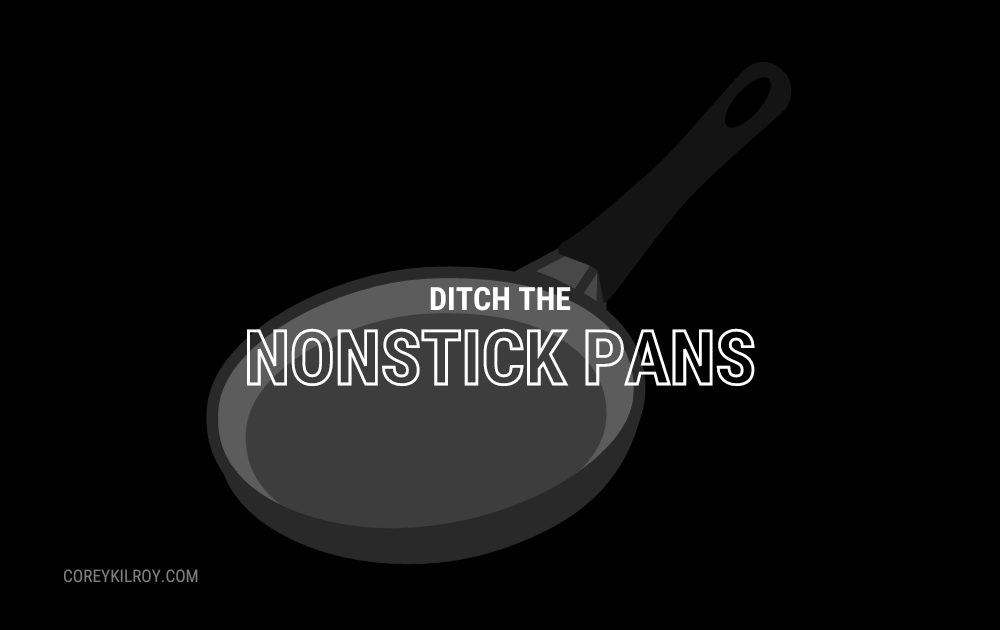Why You Should Ditch the Nonstick Pans.

I grew up in a nonstick pan household.
Eggs, chicken, stir-fry, veggies, you name it, we reached for that trusty Teflon-coated pan.
Nowadays, my stainless steel pan is my go-to, but every once in a while when I plan to make some pancakes or a cheesy, egg omelet, I’m always tempted to reach for that OG workhorse.
The convenience that comes with that Teflon-coated pan is unbeatable, so why would we ever want to use anything else?
Eggs just slide off like butter, grilled cheeses flip with no problem, and chicken slips and slides with ease.
All this convenience comes at a price, however.
That Teflon coating that’s used to synthetically cover the surface of the pan is also known as polytetrafluoroethylene (PTFE).
This Teflon was created in the 1930s and provides a nonreactive, nonstick, and almost frictionless surface.
Now, however, the safety of nonstick cookware has gone under investigation and people are starting to wake up.
The concerns are focused on a chemical called perfluorooctanoic acid (PFOA), which was previously used to produce nonstick cookware but isn’t used today.
These PFOAs have been found to cause a variety of health problems including altered immune and thyroid function, liver disease, lipid and insulin dysregulation, kidney disease, adverse reproductive and developmental outcomes, and cancer (source).
The investigations have also looked into the risks associated with overheating Teflon.
This new Teflon is considered safe as long as it doesn’t exceed 500°F (260°C).
Since this discovery, all Teflon products are said to be PFOA-free, however, PFOA was used in the production of Teflon until 2013.
While most of the PFOA on pots was normally burnt off at high temperatures during the manufacturing process, a small amount remained in the final product (source).
So now what?
Now that Teflon products are PFOA-free, there are still other components, namely PFAS (per- and polyfluoroaklyl substances), that are not fully understood.
These and other ingredients in Teflon products may pose a health risk.
I’ve read that there’s still more ongoing research to more fully understand the nature of those ingredients and how they impact the human body.
But, much is still unknown about the safety of the fluoropolymers that are used currently.
The U.S. Consumer Product Safety Commission just put out a statement on the potential risk of PFAS in products, as the EPA just warned about them in drinking water (source).
Some known health effects of PFAS include (source):
- Reproductive effects such as decreased fertility or increased high blood pressure in pregnant women.
- Developmental effects or delays in children, including low birth weight, accelerated puberty, bone variations, or behavioral changes.
- Increased risk of some cancers, including prostate, kidney, and testicular cancers.
- Reduced ability of the body’s immune system to fight infections, including reduced vaccine response.
- Interference with the body’s natural hormones.
- Increased cholesterol levels and/or risk of obesity.
These PFAS are not only prevalent in nonstick pans either, they’re said to be found in:
- Drinking water – in public drinking water systems and private drinking water wells.
- Soil and water at or near waste sites - at landfills, disposal sites, and hazardous waste sites such as those that fall under the federal Superfund and Resource Conservation and Recovery Act programs.
- Fire extinguishing foam - in aqueous film-forming foams (or AFFFs) used to extinguish flammable liquid-based fires. Such foams are used in training and emergency response events at airports, shipyards, military bases, firefighting training facilities, chemical plants, and refineries.
- Manufacturing or chemical production facilities that produce or use PFAS – for example at chrome plating, electronics, and certain textile and paper manufacturers.
- Food – for example, fish caught from water contaminated by PFAS and dairy products from livestock exposed to PFAS.
- Food packaging – for example, in grease-resistant paper, fast food containers/wrappers, microwave popcorn bags, pizza boxes, and candy wrappers.
- Household products and dust – for example in stain and water-repellent used on carpets, upholstery, clothing, and other fabrics; cleaning products; non-stick cookware; paints, varnishes, and sealants.
- Personal care products – for example in certain shampoo, dental floss, and cosmetics.
- Biosolids – for example, fertilizer from wastewater treatment plants that is used on agricultural lands can affect ground and surface water and animals that graze on the land.
Although these Teflon pans are said to not contain PFOAS anymore, I would not want to risk ingesting PFAS and other synthetic chemicals that may leak off when used to cook food.
Here are some cookware alternatives:
Stainless steel
Stainless steel is excellent for sautéing and browning food. It is durable and scratch-resistant. It’s also dishwasher safe, making it easy to clean.
These are the pans I personally use: This Set.
Cast-iron cookware
When it’s seasoned properly, cast iron is naturally nonstick. It also lasts a long time and can withstand temperatures well above those considered safe for nonstick pots and pans.
Stoneware
Stoneware has been used for thousands of years. It heats evenly and is nonstick when seasoned. It is also scratch-resistant and can be heated to very high temperatures.
Ceramic cookware
Ceramic cookware is a relatively new product. It has excellent nonstick properties, but the coating can be easily scratched.
🏁 In the end…
Nonstick cookware is found in many kitchens worldwide.
That nonstick coating is made from a chemical called PTFE, also known as Teflon, which makes cooking and washing fast and easy.
However, health agencies have raised concerns about the compound PFOA, which was previously used to make Teflon.
Today’s nonstick and Teflon cookware is considered safe for everyday home cooking, as long as temperatures do not exceed 500°F (260°C).
So, you can use your nonstick cookware on the stovetop at low-to-medium heat, but don’t use it at maximum heat or for hotter cooking methods like broiling.
Personally, I don’t want to risk the chances or potentially introduce PFAS into the food I’m cooking, despite them now being PFOA-free.
Alternatives like stainless steel or cast iron cookware are amazing non-toxic options.
At the end of the day, Teflon cookware is a convenient way to cook your food that is safer for everyday use than it was previously. However, research is ongoing on other substances used in the making of Teflon, and emerging evidence suggests there may still be safety issues.
🙇🏻♂️🌱 Until Next Time, C.
P.S. Whenever you're ready, here's how I can help you:
- Follow me on Twitter (X) and Instagram for more on improving the body, mind, & environment.



